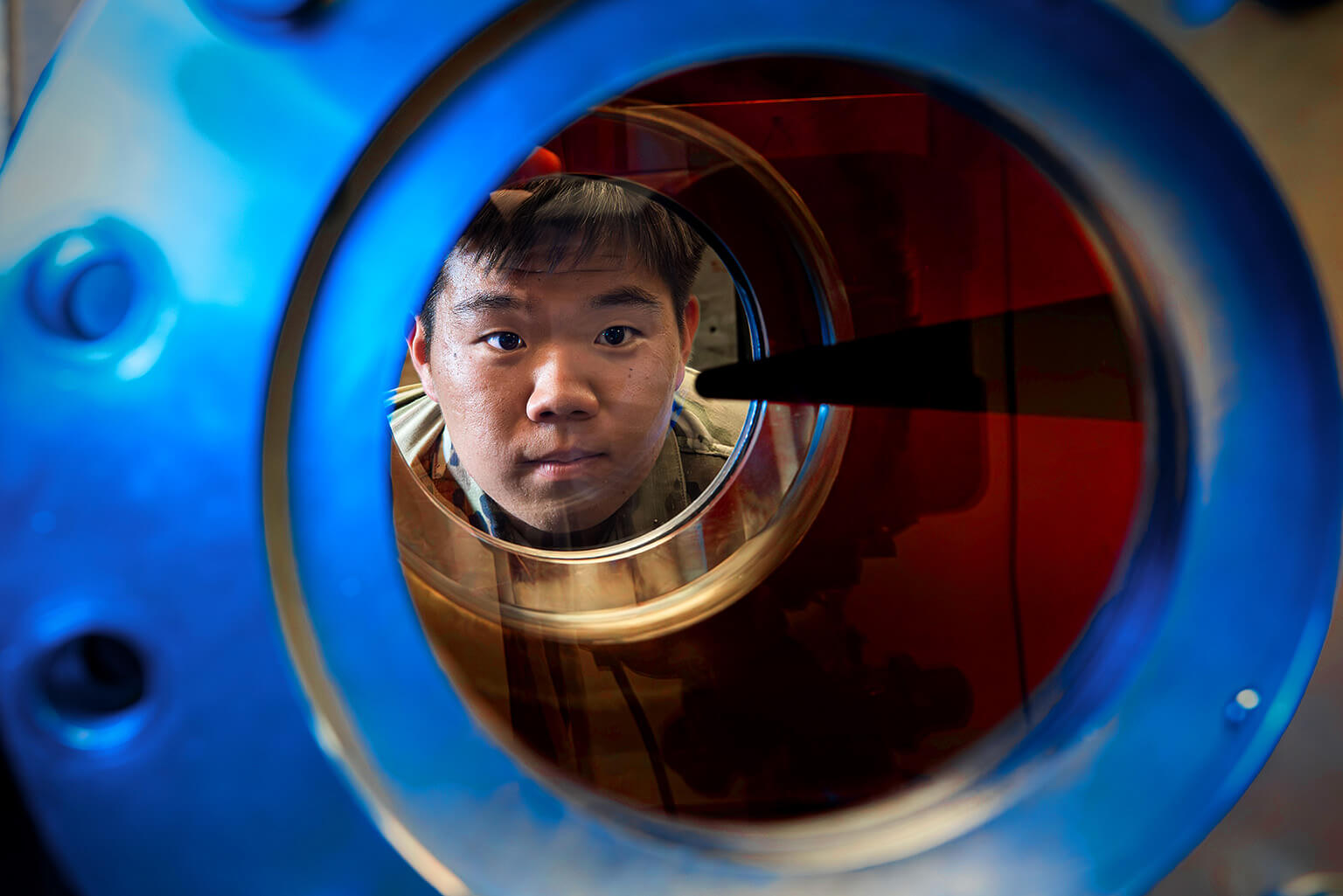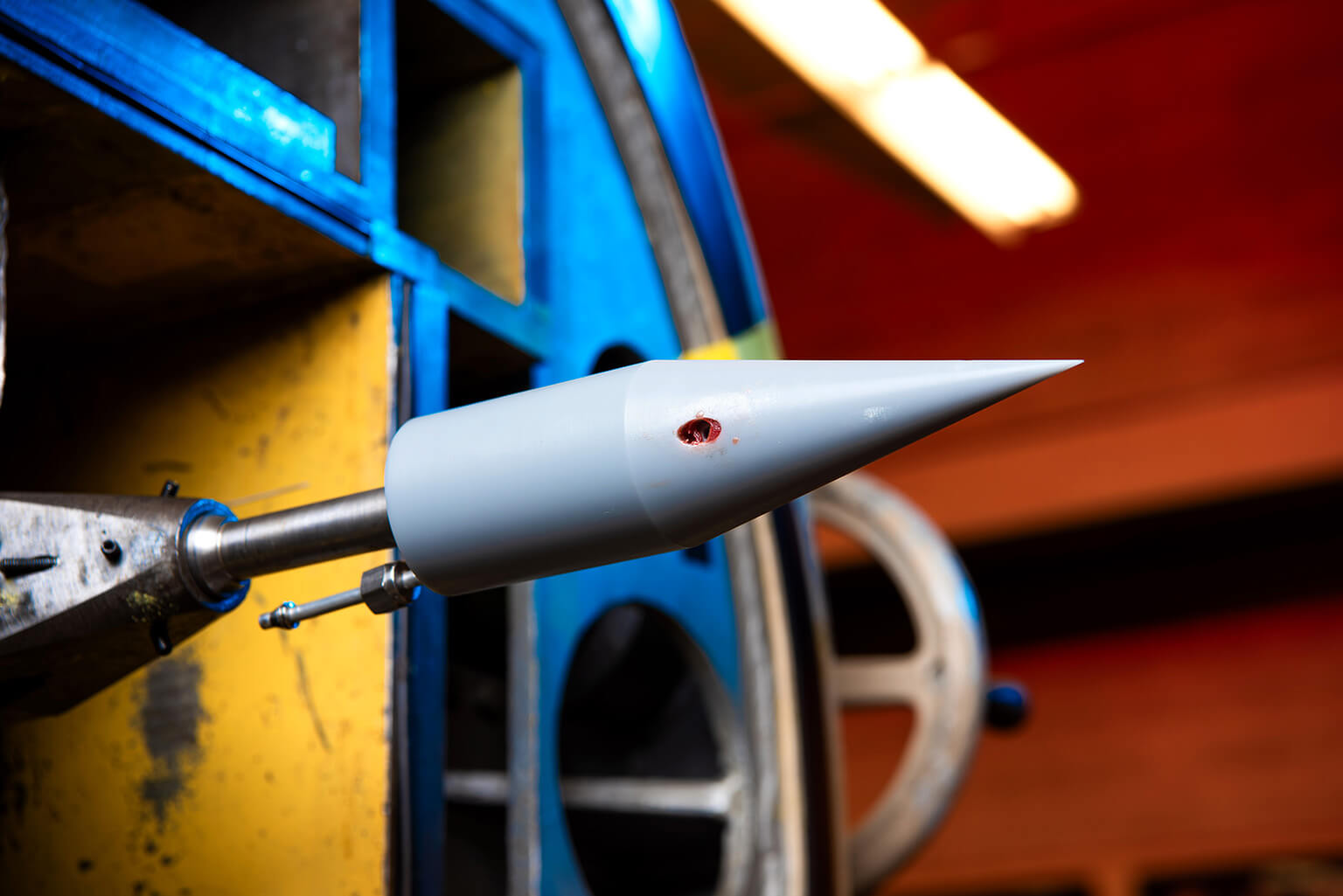Cadets test for hypersonic speeds in aero wind tunnels
 U.S. Air Force Academy Cadet 1st Class Regan Hansen inspects a control jet interaction model nose cone in the Department of Aeronautics Trisonic Wind Tunnel Aug. 29, 2023. The cadet tested jet interaction with oblique shock waves and their effects on jet effectiveness. The Trisonic Wind Tunnel can operate at speeds up to Mach 4.5. (U.S. Air Force photo by Trevor Cokley)
U.S. Air Force Academy Cadet 1st Class Regan Hansen inspects a control jet interaction model nose cone in the Department of Aeronautics Trisonic Wind Tunnel Aug. 29, 2023. The cadet tested jet interaction with oblique shock waves and their effects on jet effectiveness. The Trisonic Wind Tunnel can operate at speeds up to Mach 4.5. (U.S. Air Force photo by Trevor Cokley)
By Randy Roughton
U.S. Air Force Academy Strategic Communications
U.S. AIR FORCE ACADEMY, Colo.– U.S. Air Force Academy cadets are at the forefront of hypersonic flight research through Department of Aeronautics wind-tunnel testing.
Cadets perform hypersonic testing primarily in two high-speed wind tunnels. The Hypersonic Mach 6 Ludwieg Tube is a 0.5 meter diameter, 35-meter tunnel that can test up to six times the speed of sound, showing how hypersonic shapes warm from the high-speed flow. The 1-by-1-foot Trisonic Wind Tunnel tests aircraft and missile shapes at transonic and supersonic speeds. Hypersonic weapons travel at speeds of 3,500 mph and higher, much faster than the speed of sound.
‘A new frontier’
Cadets test different shapes of new missiles in the Trisonic Wind Tunnel, said Lt. Col. Dell Olmstead, head of the Department of Aeronautics. Cadets answer questions such as how to intercept the adversary’s weapons in a long-range fight, develop more aerodynamic missiles for a longer range, and steer weapons to make them more difficult to spoof.
“Our cadets are not solving the aviation problems that I solved,” Olmstead said. “They are going to be solving the problems of the 21st century. We are talking about a new generation. This is a great-power competition. This is hypersonics. This is [artificial intelligence]. This is quantum computing. These are the problems and the opportunities of our cadets’ generation.”
“It’s almost like we’re on this new frontier, where everything we do is brand new,” said Cadet 1st Class Regan Hansen. “Everything you do feels like you’re accomplishing something that the world has never seen.”
 U.S. Air Force Academy Cadet 1st Class Sung Choi peers through the window of the Department of Aeronautics Hypersonic Mach 6 Ludwieg Tube he tested for class Aug. 29, 2023. (U.S. Air Force photo by Trevor Cokley)
U.S. Air Force Academy Cadet 1st Class Sung Choi peers through the window of the Department of Aeronautics Hypersonic Mach 6 Ludwieg Tube he tested for class Aug. 29, 2023. (U.S. Air Force photo by Trevor Cokley)
The value of cadet wind-tunnel research
The cadets’ wind tunnel testing is crucial in the push for more effective hypersonic aircraft and weapons. Indeed, the Department of Aeronautics maintains up to 40 partnerships at any given time.
“That is because the research has value, and many of our [partners] know the value of our cadets to the research,” Olmstead said. “One of the things that I am most proud of is the [Aeronautical] Research Center is wholly focused on cadet-centric research, meaning all the amazing things that we are doing, we are doing because the cadets are in the middle of them.”
 Pictured is a control jet interaction model nose cone in the U.S. Air Force Academy Department of Aeronautics Trisonic Wind Tunnel Aug. 29, 2023. Cadets test jet interaction with oblique shock waves and their effects on jet effectiveness. (U.S. Air Force photo by Trevor Cokley)
Pictured is a control jet interaction model nose cone in the U.S. Air Force Academy Department of Aeronautics Trisonic Wind Tunnel Aug. 29, 2023. Cadets test jet interaction with oblique shock waves and their effects on jet effectiveness. (U.S. Air Force photo by Trevor Cokley)
Our partners come to the Academy for a specific reason. Nowhere else can they get the combination of cadet engagement and research-grade technology available in the Aeronautical Research Center, Olmstead said.
“Our wind tunnels are here for the sole purpose of undergraduate education,” Olmstead said. “Nowhere else in the country has the caliber and quantity of wind tunnel facilities available to undergraduate students. [The facilities] are not here for the next PhD student. They are here for our undergraduates, and that does not exist anywhere else in the country.”
From testing to implementation
Aeronautical cadets are not only at the forefront of hypersonic research. Olmstead said the cadets could one day implement and use the hypersonic technologies they are testing today when they are Airmen and Guardians.
“One of the hallmarks of a great-power competition is a rapid technological evolution is required,” he said. “Our cadets are learning how to do this rapid technological innovation in these courses.”
For more wind tunnel photos, see Flickr.